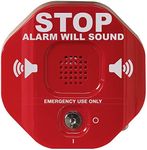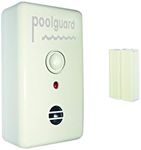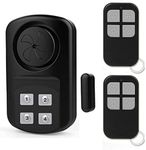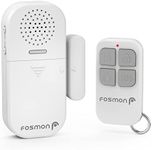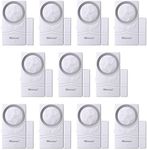Buying Guide for the Best Child Door Alarm
Choosing a child door alarm is an important step in keeping your home safe and giving you peace of mind. These alarms are designed to alert you when a door is opened, helping you monitor your child's movements and prevent them from wandering into unsafe areas. When picking the right alarm, it's important to consider how it will fit into your daily routine, the layout of your home, and your specific safety concerns. Understanding the key features will help you make a choice that best suits your family's needs.Alarm VolumeAlarm volume refers to how loud the alarm sounds when triggered. This is important because you want the alarm to be loud enough to alert you, but not so loud that it startles your child or disturbs the whole household. Alarm volumes typically range from soft chimes to loud sirens. Softer alarms are suitable for small apartments or if you want a gentle reminder, while louder alarms are better for larger homes or if you need to hear the alarm from a distance. Consider your home's size and where you spend most of your time when choosing the right volume.
Sensor TypeThe sensor type determines how the alarm detects when a door is opened. The most common types are magnetic sensors and motion sensors. Magnetic sensors work by detecting when the connection between two parts is broken as the door opens, while motion sensors detect movement near the door. Magnetic sensors are reliable for standard doors, while motion sensors can be useful for sliding doors or if you want to monitor a wider area. Think about the type of doors you have and where you want to place the alarm to decide which sensor type is best for you.
Power SourceChild door alarms can be powered by batteries, plugged into an outlet, or sometimes both. Battery-powered alarms are easy to install anywhere and are portable, but you need to remember to check and replace the batteries. Plug-in alarms don't require battery changes but need to be near an outlet, which can limit placement options. If you want flexibility and easy installation, battery-powered might be best. If you prefer not to worry about batteries, look for a plug-in model, or consider one that offers both options for backup.
Installation MethodInstallation method refers to how the alarm is attached to your door. Some alarms use adhesive strips, while others require screws or brackets. Adhesive strips are quick and easy to use, making them ideal for renters or those who want a non-permanent solution. Screw-mounted alarms are more secure and less likely to fall off, which is good for long-term use or high-traffic doors. Consider whether you want a temporary or permanent solution and how comfortable you are with basic installation tasks.
Alert OptionsAlert options describe how the alarm notifies you when the door is opened. Some alarms only sound a noise, while others can send notifications to your phone or connect to a home security system. Basic sound alerts are simple and effective for most needs, but if you want to be notified when you're not at home or in another part of the house, look for alarms with smart features or app connectivity. Think about your daily routine and whether you need remote alerts or just a local sound.
Tamper ResistanceTamper resistance means how well the alarm can withstand being disabled or removed by a curious child. Some alarms have features like hidden switches, secure mounting, or alert you if the alarm is tampered with. If your child is very curious or tends to play with gadgets, look for alarms with strong tamper resistance to ensure the alarm stays effective and in place.
